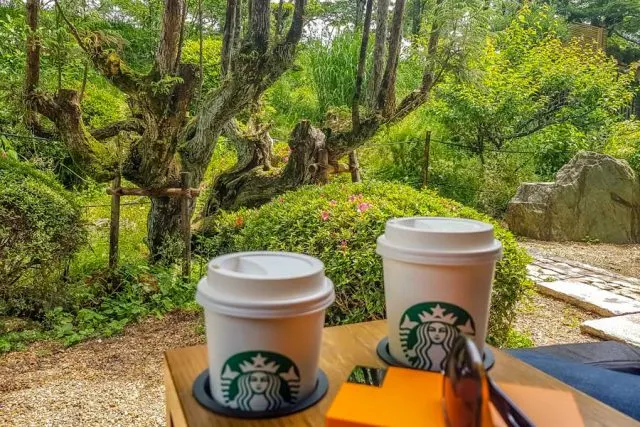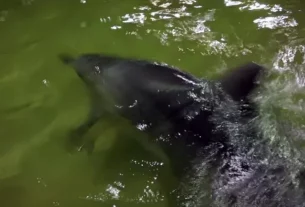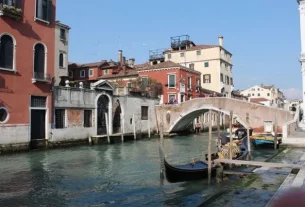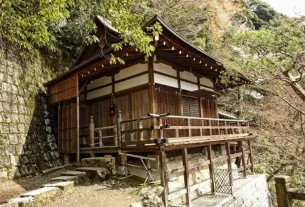If you want to get away from the crowds and still be within easy reach of the major cities in Kansai, then Uji is worth your consideration. It’s inexpensive to get here from Kyoto and Osaka, you won’t need a JR pass for this one although you can utilize it if you have one active. All the essentials including how to get here are included below and it’s perfect for exploring on foot so we’ll suggest a walking route together with our free map to use in your planning.

With the picturesque river and backdrop of green hills, there is a lot to love about the small city of Uji on the outskirts of Kyoto. There are the World Heritage sites, a tea culture dating back to the 11th century and a connection to the worlds first novel that add an element of culture and interest. For the foodies too it really is a great addition to your plans in Kansai.
Table of Contents
Getting to Uji
Uji is convenient to access from many areas within the Kansai area. It’s part of Kyoto prefecture and a very easy day trip from Kyoto city but it’s also an ideal place to visit from several other nearby cities including Osaka, Nara, and Kobe.
By train from Kyoto station, you can use either the JR or Keihan train companies. The Keihan station is closer to the river but on the opposite bank to the most popular attractions, the JR station is a little further back from the river but on the side where you’ll probably want to start your day.
If you consider the Byodo-in Omotesando, the shopping and restaurant street the runs parallel to the river along to the famous temple, as the heart of the area then it’s a 500 m walk from Keihan and a 700 m walk from JR. Under 10 minutes either way and only a couple of minutes difference. There really isn’t much in it so I’ll cover both options and why you would choose one over the other.
Getting to Uji by Japan Rail
This option is best if you have an active JR Pass you want to use. It’s also most convenient if you’re arriving at JR station from another city by bullet train or staying nearby. It will cost Y240 and you will travel on the JR Nara line. If you catch the rapid it will take 18 minutes, if you get a local train that stops at every station it will be just under 30 minutes. The cost is the same either way.
Getting to Uji by Keihan Railway
Travelling by Keihan Railway is convenient if you’re staying in central Kyoto where it will be easier to catch a Keihan train from stations such as Sanjo or Gion-Shijo. You will take an unreserved seat in the limited express for Yodoyobashi (Osaka) and make a quick change about 12 minutes in at Chushojima station, continuing on the Uji line. It’s a small station so the interchange is simple and quick, the trip will take just fractionally over 30 minutes and costs Y310. If you are coming from central Kyoto that will save the cost and time of making your way into Kyoto station.
I’d also recommend Keihan as an option if you are coming from Osaka. It’s under an hour from Yodoyabashi station including the same change at Chushojima station and costs Y420. You can access Yodoyabashi easily on the Midosuji subway line from most parts of Osaka including Umeda, Namba and Shin-Osaka station.
Things to do in Uji
Uji offers a variety of attractions that will appeal to a wide range of visitors including gardens, Japanese arts, culture, and history. It’s known worldwide for its green tea production and has a picturesque river running through the town. The famous Byodo-in temple, a world heritage site featured on the Y10 coin is here and if you’re a literary buff you’ll probably know that it features heavily in the Tale of Genji, the world’s first novel that provides fascinating insights into life in the Heian Court.
With so much to see let’s take a look around.
Uji Bashi Bridge

Coming from the station you’ll come first to the Uji Bashi bridge. Although it was reconstructed in 1996 and therefore modern in design, it retains some traditional design features including its shape, the Japanese Cypress decoration, and bronze caps.
It’s more the location of the bridge over the Uji River that is notable, and the reason that it’s recognized as one of the three most ancient bridges in Japan. The first bridge was built here in the year 646 by the monk Douto of Gango-ji temple in Nara.
Murasaki Shikibu Statue

Perhaps it’s just bookworms and literature lovers who will understand but I was kind of excited to visit Uji knowing that it featured so prominently in the first novel ever written.
The statue is Murasaki Shikibu, a lady-in-waiting of the Imperial Court, poet and novelist. She wrote the novel The Tale of Genji which has since been translated into many other languages including English. It is thought to have been written between the years 1000 and 1012 making it the world’s first full-length novel. It was popular within the medieval Court but equally so today for the complex picture it gives of life at that time, from clothes to attitudes, relationships and Court life.
Byodo-in Omotesando

As you pass the statue you enter the shopping street that is the approach to Byodo-in Temple. This is filled with small shops, cafes, and snacks. What is most striking is the consistent theme of green tea.
There are small tea shops and cafes to sit for a drink, you can buy it to take home, choose from a wide range of omiyage (souvenirs), get a delicious matcha ice-cream cone or order an entire meal themed on tea. We were also able to watch matcha-flavoured noodles being made and cut by hand with incredible precision in the front window of a restaurant here.
Even Starbucks is something special in Uji

I’ve talked many times about how much I love the various forms of Japanese tea and I made sure to indulge in that several times throughout the day in Uji. However, you will notice that Japan does Starbucks in its own unique way too. This one is located towards the end of the approach just as you reach the entry garden to Byodo-in Temple.
Given I’m also partial to a soy chai latte we couldn’t resist a stop in here just before we reached Byodo-in Temple for a morning cuppa. There is plenty of indoor seating too but you could take your pick of these seats facing out across the rock garden on the side or at the back there were seats looking out over the woodland garden with the sounds of the river running behind.
Byodo-in Temple

The most recognised attraction in Uji is the beautiful Byodo-in temple, not only is it a UNESCO world heritage site but you might recognise it from the Y10 coins that fill up your pockets and purse in Japan. Well, they seemed to be a constant until we rummaged through looking for a coin to do the iconic shot in front of the temple and couldn’t scatch one up between us.
Byodo-in was established in 998 as the residence of Fujiwara no Mihinaga, a prominent politician of the time. It wasn’t until 1053 that his son turned it into a temple and added the distinctive Phoenix Hall named for both its shape and the gold phoenix on the centre roof.

The Phoenix Hall has had regular maintenance, including some internal work while we were there in May but it has been spared from fire or major damage making it one of the few main temple halls remaining from the Heian period. When it isn’t undergoing work you can do a tour inside for Y300 and it runs three times an hour.
You’ll want to allow some time at Byodo-in, it’s a large complex with lovely gardens, sub-temples and other features.
Hoshokan Museum

The museum is within the grounds of Byodo-in Temple but does warrant special mention and is worth a visit in its own right. When it was established in 2001 the design was challenging, it needed to incorporate all modern features to protect the priceless treasures of the temple that would be displayed but also to integrate the building itself sympathetically into the grounds of a more than 1000-year-old temple without impacting on the famous view.
The gallery is substantially underground but as a visitor, it doesn’t feel oppressive due to the way space and light have been managed. No photography is allowed inside and that forces you to be present and really appreciate the treasures on display.
Sabo TOKA tea salon
Within the grounds of the world heritage temple, you can enjoy traditional tea and sweets in a modern way. The purpose-built TOKA tea salon is adjacent to the museum and enclosed by floor-to-ceiling glass providing uninterrupted views of the garden beyond.
Their custom tea is blended exclusively from tea leaves grown in Kyoto prefecture including Uji city and the surrounding farms. The tea salon offers both hot and cold tea sets including a small sweet ranging from Y550 to Y850.
Cormorant fishing on Uji-gawa river

Uji is one place in Japan where ukai (鵜飼) or traditional cormorant fishing still takes place. During a summer’s evening, you can see the fishermen from the shore or take a boat ride out on the river. While it’s a historical practice it’s continued predominantly for the tourists and involves the use of captive birds that are harnessed to prevent them from eating the catch.
While this was something we weren’t comfortable with seeing personally we did find Uji to be a great place for anyone with an interest in birds and nature. There are many wild cormorants along the river, they perch on the rocks and river walls as they wait for their wings to dry and put on their own entirely natural displaying catching their food every day. You are sure to spot a few on a walk along the river’s edge.
We also saw turtles, fish, the elegant Japanese heron, ducks and a variety of small birds, especially as you get closer to the forest. If you are interested in this aspect of Uji we’d recommend allowing extra time to walk along the north bank of the river towards the dam and into the hills. You’ll also see more as we head up to the shrines in the foothills and to the lookout.
Tachibanajima & To-no-Shima Islands

There are 2 narrow conjoined islands in the Uji River not far from Byodo-in Temple. They are connected by bridges to each bank and to each other, it’s a convenient way to cross to the east bank and start out close to several key attractions.
There’s a stone pagoda and several small commemorative plaques on the island but mostly it’s recreational space to walk or sit and enjoy the quiet of the river and the beautiful view on either side. It would be especially picturesque during the spring blossom or the autumn leaves seasons but even in its fresh lush foliage of late spring, it was really beautiful.
Fukujuen Tea Museum

It’s a short walk after crossing the bridge to the east bank of Uji to the Fukujuen tea factory, a small tea shop, cafe and museum.
Go through the shop on the ground floor to the museum at the back, there is some signage and brochures in English. The tea room and workshop space are upstairs and can be accessed by a lift if required.
Uji Shrine

Uji and the adjacent Ujigami shrine were historically the upper and lower sections of a single shrine built in the nagare-zukuri style. They were separated during the Meiji period and if you were only to visit one it would be the upper (Ujigami) Shrine.
As you will be passing Uji Shrine on the way a detour down this pretty approach to the lower shrine and continuing on to Ujigami Shrine through the side gate is suggested.
Ujigami Shrine

Another of Uji’s world heritage listed attractions is the Ujigami Shrine. It borders the forest behind and the access is down this tree-lined approach to the tori gate.
The Shrine was built in the late Heian period around 1060 and the main hall, the original honden has been shown through scientific dating to support that, making it the oldest Shinto building in Japan
The Seven famous springs in Uji

The Kirihara-no-mizu is one of 7 famous springs that historically existed in Uji. It is located within the grounds of Ujigami Shrine to the right of the gate and main hall.
There are four components to excellent tea; the leaves, the water quality, the water temperature and the skill of tea master. Besides the premium tea leaves grown in the surrounding area, Uji was also known for its tea because it had so many underground pure water springs.
There were 7 of those wells that were collectively known as ‘Uji-shichi-meisui’ or the 7 famed springs of Uji. They became known for the properties of the water drawn from them. Some have been lost over the course of time but the one at Ujigami shrine is still in use. It serves as the chōzuya used during the cleansing ritual when visiting a shrine.
The Tale of Genji Museum
Various statues and markers related to the book, The Tale of Genji, are located around Uji and have been passed along the walking route we followed here. If you have an interest in the story then a museum that houses various exhibits and scenes from the novel is located just a few minutes walk from the shrines.
There is some English translation available but the museum will mostly appeal to those who know the story although it also provides some interesting insight into Japans aristocracy during the Heian period.
We didn’t go in on this trip as we’d been to see an exceptional display of hand-painted screens depicting Prince Genji’s birthday party at Nezu Museum in Tokyo the previous week so we satisfied ourselves with the various exhibits around town.
Daikichiyama Fuchi Park Lookout
A little further on from Uji Shrine or the Tales of Genji museum you begin the wind uphill to the Daikichiyama Observatory with spectacular views out over southern Kyoto and beyond. The walk is on good sealed paths and will take you less than 30 minutes.
Although the view from Mt Daikichi (or in Japanese Daikichiyama) is beautiful it is really is quite a small hill and a suitable walk for the whole family. If you look at the photo at the top of the page where we are crossing the bridge from the island, the lookout is only part of the way up the hill you see in front of us there.
We’ve left this for the end of the day as the lookout faces west making it the best spot to watch the sunset and the night view from here is also quite special from up here if you choose to stay on to see the lights come on across the city.
An Uji map to plan your visit
I’ve created the map in Google Maps as it’s an application that most people have on their phones. It’s a fairly reliable mapping tool and can be downloaded when you have connectivity to provide some functionality even when you are without an internet connection if you need that.
While this walking course is easy to complete in a day with plenty of time to stop and enjoy the various activities and local cuisine along the way we don’t necessarily suggest that it will be the ideal route for everyone. Feel free to add or omit to suit your own travel style and interests. That’s the joy of independent travel, always follow that laneway or path that catches your attention, you know know what you’ll find.
If you do have any questions about the various activities or information when planning your trip we are always happy to talk travel and share our own experience. Please feel free to reach out either through the comments section at the bottom of the page or through the contact information.
Additional tips for visitors to Uji and the rest of Kyoto

We find having connectivity when we travel to Japan so much more important than in any other places. Firstly there isn’t free WIFI universally available and if you don’t read and write Japanese fluently then having access to translation tools, information, maps and transport timetables in English is going to make your visit far smoother and more enjoyable.
If you are travelling from Australia then we use and recommend WIFI2Go. We have the device in our hand and ready to go as we land, on our most recent trip ours was literally connected before we disembarked the plane and no time was wasted collecting it. Mentioning ‘2 Aussie Travellers’ when you book will get you a discounted rate of $8 per day for unlimited data.
I don’t know of a similar service for other countries but we do use and trust Klook for booking a variety of services when we travel and have had good feedback on this WIFI deal for airport collection.
Interested? Pin these images to Pinterest to read later & share



